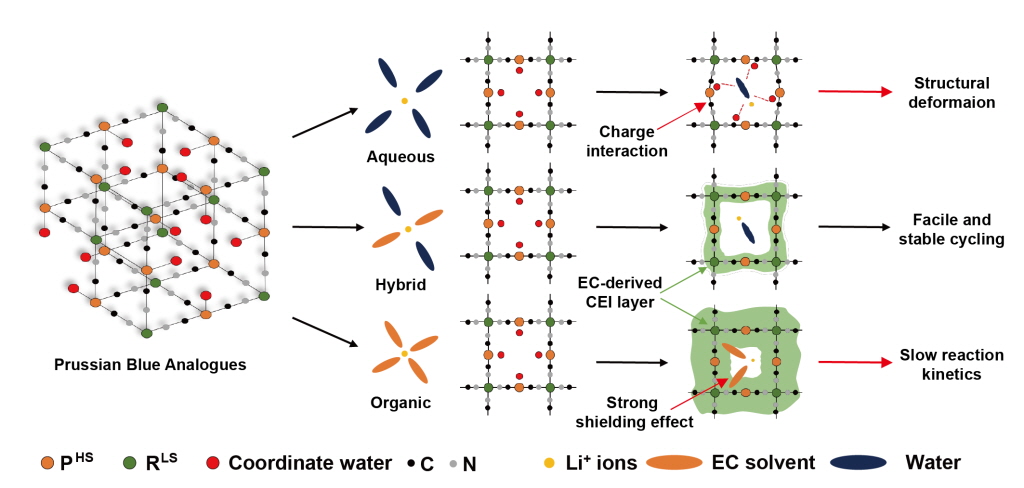UNIST(총장 이용훈) 에너지화학공학과 이현욱 교수팀이 프러시안 블루를 양극재로 활용해 배터리 성능을 크게 높이면서도 값싼 리튬 이차전지 시스템을 개발했다.

▲전해질 디자인을 통해 안정적인 코팅층 형성으로 프러시안 블루의 구조 안정성 확보 및 고출력 특성 향상
전해질 장점 결합 500사이클 이상 배터리 성능 유지
UNIST 이현욱 교수팀, 프러시안 블루 양극재 활용
청바지 염료로 잘 알려진 프러시안 블루(Prussian Blue)가 차세대 배터리 소재로 떠오르고 있다. UNIST 연구팀은 프러시안 블루를 활용한 저비용 고성능 리튬이온전지를 개발해 전지 가격을 낮출 수 있는 방법을 찾아냈다.
UNIST(총장 이용훈) 에너지화학공학과 이현욱 교수팀이 프러시안 블루를 양극재로 활용해 배터리 성능을 크게 높이면서도 값싼 리튬 이차전지 시스템을 개발했다고 24일 밝혔다. 기존의 배터리에서 사용되는 유기계와 수계 전해질의 장점을 결합해 성능을 극대화했다.
개선된 전해질은 배터리 작동 중에 물 분자를 제거하고 프러시안 블루 표면에 안정적인 보호층을 형성한다. 이를 통해 500사이클 이상에서도 안정된 용량(125mAh/g)을 유지할 수 있다. 새로운 전해질이 배터리의 내구성을 크게 향상해 고출력에서 안정적으로 구동하게 만드는 것이다.
기존 프러시안 블루 양극재는 유기 전해질에서 반응 속도가 느리거나 구조적 불안정성으로 에너지 밀도와 수명 성능에 한계가 있었다. 반면에 이러한 문제를 해결함으로써 프러시안 블루의 활용도를 높여 저렴하면서도 효율적인 배터리 소재를 만들 수 있다.
리튬이온전지의 주요 양극재인 리튬전이금속 산화물에는 코발트와 니켈이 포함되어 있다. 이들 자원 가격이 상승하면서 배터리 가격도 급등했다. 이에 따라 값싼 철이 포함된 리튬인산철이 주목받고 있는 이유다.
프러시안 블루는 철, 탄소, 질소로 이루어진 값싼 물질로, 생산 비용이 낮고 이온전도도가 높아 다양한 이온을 수용할 수 있다. 이러한 특성 덕분에 차세대 배터리 소재로 각광받고 있다. 그러나 리튬을 활용하는 데 한계가 있어 많은 연구가 이루어지지 않았다.
저렴하면서도 효율적인 양극재인 프러시안 블루는 리튬이온전지의 가격을 크게 낮출 수 있는 잠재력을 보였다. 전해질 개선을 통해 성능을 최적화하여 프러시안 블루의 한계를 극복하고 다양한 배터리 분야에 적용될 것으로 전망된다.
이현욱 교수는 “기존 리튬이온전지 시스템에서 괄시받던 프러시안 블루를 매력적인 저가 양극 소재로 탈바꿈하여 값싼 양극 소재 개발의 패러다임이 바뀔 수도 있을 것”이라 전망했다.
제1저자 위태웅 연구원은 “이번 연구를 통해 기존 프러시안 블루의 한계를 극복할 뿐만 아니라, 향후 보다 효율적이고 안정적인 배터리 개발에 기여할 수 있을 것”이라고 강조했다.
제1저자 박창현 연구원은 “전해질에 물 분자가 포함된 리튬수계기반전해질에서 프러시안 블루를 안정적으로 구동한 최초의 연구”라며 그 의의를 밝혔다.
이 연구 성과는 한국연구재단 중견연계 신진후속사업의 지원으로 수행됐으며, 나노과학 분야 국제학술지 Nano Letters에 6월13일자로 게재됐다.
